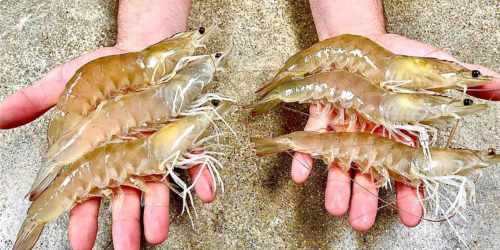Shrimp farming is a successful industry in Nigeria. This is due to Nigeria’s abundant natural resources, and many places throughout the world can generate big quantities of shrimp. Furthermore, with an annual revenue of more than 18 billion US dollars, shrimp is the most profitable seafood enterprise in the world. As a result, it is a viable option for beginning shrimp farming in Nigeria, whether indoors, at home, or outdoors.
This article is a step-by-step guide to getting your shrimp farm up and running so you can contribute your much-needed supply to the world shrimp market.
What Is A Shrimp or Prawn?
Shrimp or prawn farming, often known as aquaculture, is the commercial cultivation of it in controlled conditions. The term “pester” refers to a type of fish that is found in the wild.
Shrimp and prawns are marine crustaceans that live at the bottom of the sea in most regions across the world. They are invertebrates, which means they lack a backbone. Shrimps and prawns, on the other hand, have a hard exoskeleton (the shell of the shrimp).
Is Shrimp Farming Profitable in Nigeria?
Yes, shrimp farming in Nigeria can be profitable. This is due to the country’s extensive coastline, which includes numerous estuary and lagoon systems excellent for shrimp farming. Furthermore, the environment is warm and humid, which is ideal for shrimp farming. There are numerous elements that influence whether or not shrimp farming is lucrative in Nigeria.
These include input costs (such as feed, feedstock, and fingerlings), output costs (shrimp), and farm productivity. This farming, in general, requires more labor than other aquaculture varieties. As a result, labor costs are frequently a crucial element in deciding profitability. However, cheap labor is prevalent in Nigeria, making prawn farming more practical.
Benefits of Shrimp or Prawn Farming In Nigeria and Africa
The shrimp farming company offers numerous advantages. That is why it is progressively gaining favor. We are attempting to describe the top benefits of this business here.
- High demand: Shrimp and prawns are in high demand, ensuring producers a constant market.
- Profitable: Shrimp and prawn farming can be quite profitable if properly handled.
- Job creation: Shrimp and prawn farming generates employment in local communities, hence supporting economic growth.
- Nutritious: Shrimps and prawns are high in protein, vitamins, and minerals, making them a nutritious meal choice.
- Environmentally friendly: Shrimp and prawn farming can be done in a sustainable and eco-friendly way, lessening environmental impact.
- Low water consumption: Shrimp and prawn farming use less water than other forms of aquaculture, making it a more sustainable option.
- Low feed conversion ratio: Shrimp and prawn farming have a lower feed conversion ratio than other types of livestock farming, which reduces costs.
- Reduced impact on wild stocks: As demand for seafood grows, shrimp and prawn farming can help to relieve pressure on wild populations.
- Diversification: Shrimp and prawn farming provide farmers with an additional source of income and diversification.
Types Of Shrimps or Prawns Used For Shrimp or Prawn Farming In Nigeria
In Nigeria and Africa, various types of shrimp or prawns are utilized for shrimp or prawn farming. These are some examples:
- Giant tiger prawn: This is one of the most widely farmed prawn species. It is a rapidly expanding species recognized for its huge size and delectable taste.
- Whiteleg shrimp: Another popular species that is commonly grown in Nigeria and Africa is whiteleg shrimp. It is a tough species that can survive in a variety of water conditions.
- Blue shrimp: This species is famous in the decorative shrimp trade due of its brilliant blue hue.
- Freshwater prawn: Because of its big size and mild flavor, this species is well-suited for farming in freshwater ponds.
- Pacific white shrimp: Pacific white shrimp are extensively farmed in Asia, but they are also grown in Nigeria and Africa. It’s well-known for its rapid growth and high yield.
- Indian white prawn: Although this species is famous in India, it is also cultivated in other regions of the world, including Nigeria and Africa.
- Red claw crayfish: The red claw crayfish, while not strictly a shrimp or prawn, is a popular freshwater crustacean cultivated in Nigeria and other parts of Africa. It is well-known for its size and meaty flesh.
Farmers in Nigeria and Africa select shrimp and prawn species based on local market demand, farming techniques, and environmental circumstances. Each species has distinct growth patterns, feeding habits, and water quality requirements, therefore farmers must choose the appropriate species according on their farming conditions and market demands.
How to Start Shrimp Farming Business
As previously said, shrimp farming is really simple. This business can be started by anyone. However, if you want to raise shrimp in tanks utilizing new technologies, you must first go through training.
So, before beginning large-scale commercial production, attempt to get practical understanding. In this section, we will try to explain more about the stages involved in starting and running a successful shrimp farm.
#1. Land Selection
First and foremost, you must choose an excellent site for your new venture. It is preferable if the chosen site is quiet and devoid of noise and pollution. It is best to avoid residential areas.
Make certain that your chosen area has access to electricity, water, and reliable transportation. If your existing site has all of these amenities, you can begin commercial production on it.
#2. Type of Your Farm
You can begin producing shrimp in a variety of ways. You can cultivate shrimp in earthen ponds, concrete tanks, plastic tanks, or any other sort of water reservoir.
#3. Pond Design & Construction
Consult with an existing shrimp farmer in your area for valuable advice on pond design and building. A modest pond with sufficient water depth is perfect for shrimp farming.
You can also contact your local fisheries institute to learn more about pond design. A well-managed pond helps to keep the fish in good health and promotes faster growth.
#4. Tank Setup
If you want to raise shrimp in tanks, you must build the tanks precisely. You can build a concrete tank, a plastic tank, or any other sort. For further information, please consult with an expert.
#5. Soil Quality
Before establishing the land for shrimp farming, the types and texture of the soil in your chosen area should be investigated. Take soil samples at random (ideally up to a depth of 0.5 meter).
And conduct physical and chemical testing to detect acidity, organic load, fertility, and physical makeup.
The presence of sufficient clay competition in the soil is critical for shrimp production. Commercial production requires sandy clay or sandy loam soil.
#6. Water Quality
Maintaining adequate water quality is also critical for the shrimp farming industry. Water quality encompasses all of water’s inherent physicochemical and microbiological properties.
The right pH level is critical in the shrimp farming sector. The water’s pH should be between 7.5 and 8.5.
Determine the changes in the dissolved oxygen level in the water as well. This level should not be less than 4 ppm.
#7. Shrimp Species
It is critical to choose the proper shrimp species. If you reside in a freshwater environment, you can choose Giant River Prawn.
If you have access to saltwater, you can also choose Giant Tiger Prawn. Choose a breed based on what is available in your area.
#8. Feeding
This is the most crucial aspect of current commercial shrimp farming. Because excellent, nutritious diet promotes growth and maximum output.
Traditional shrimp producers rely on natural sources to feed their shrimp. However, if you want a good output, you must provide them with adequate supplemental meals.
There are numerous companies today that manufacture commercial feeds for shrimp feeding. This type of meal is made specifically for feeding shrimp. You can improve your productivity by using these ready-made commercial foods.
#9. Breeding
You should buy the fry from hatcheries rather than rearing them on your own farm. Shrimp breeding is a highly tough process that requires a lot of money and technical knowledge.
#10. Caring & Other Management
Taking care of the shrimp is critical for commercial production. Good care allows the shrimp to remain healthy and grow faster. As a result, attempt to take good care of them.
Keep an eye on the shrimp’s health on a frequent basis. If you run into any difficulties, seek the assistance of a professional.
#11. Harvesting
The majority of shrimp species grow quickly. They will quickly gain marketing clout. You can collect all of the shrimp at once, or you can collect the larger ones first and the tiny ones later. There are numerous local methods for gathering shrimp.
#12. Advertising and marketing
Shrimp marketing is simple. It is one of the most significant advantages of the shrimp farming company. You would most likely be able to sell your products readily on the local market.
Challenges of Shrimp Farming in Nigeria
Environmental degradation, water pollution, and social difficulties such as forced evictions and child labor are just a few of the challenges involved with shrimp farming. Shrimp farming has the potential to severely degrade the environment. Because of the intensive nature of shrimp production, pesticides and antibiotics are frequently overused, which can contaminate streams and threaten local ecosystems. Furthermore, shrimp farms frequently destroy mangrove forests to make space for ponds, leading to habitat degradation.
Another major issue related with shrimp farming is water contamination. High nitrogen and phosphorus levels in shrimp pond waste can cause algal blooms and oxygen deprivation in receiving waterways. This can cause major problems for local fisheries and those who rely on them for a living. Finally, severe societal difficulties are related with shrimp farming in Nigeria.
How Do You Make Shrimp Grow Faster in Nigeria?
There are several things that can be done to help shrimp grow quicker in Nigeria. One is to feed them a high-quality diet. This entails providing them with a well-balanced meal rich in the nutrients they require for growth. Another method for accelerating shrimp growth is to give them with a clean and spacious environment.
This includes keeping their tanks clean and free of trash, as well as giving them plenty of space. Finally, it is critical to maintain a steady water temperature. This will keep the shrimp happy and allow them to grow as quickly as possible.
Is Indoor Shrimp Farming Profitable in Nigeria?
Yes, indoor or home shrimp farming in Nigeria can be profitable. The main reasons for this are Nigeria’s high demand for shrimp and the relatively low cost of starting and sustaining an indoor or home shrimp farm.
How Long Do Shrimp Take to Farm?
Several considerations must be considered. However, most shrimp are ready for selling between the ages of 3 and 6 months.
How to Start a Shrimp Farming Business?
It is relatively simple to start a shrimp production business. Choose your farm area, evaluate the water and soil, apply the necessary fertilizers and medications, stock high-quality juvenile shrimp, give them high-quality food, and care for them.
How Fast Do Shrimp Reproduce?
The female begins to generate a significant number of eggs six to twenty hours after mating, which she carries under her belly.
What Do You Feed Shrimp?
To ensure that your shrimp grow properly, feed them ready-made commercial shrimp feeds.
What are the Shrimp Farming Equipment in Nigeria?
You will need some basic equipment if you want to start shrimp farming in Nigeria. A pond or tank, an aeration system, a filtration system, and heaters are all included. Netting will also be required to keep the shrimp and predators out.
How Big of a Tank Does a Shrimp Need in Nigeria?
Farmers in Nigeria are advised to utilize tanks of at least 16 square meters in size for shrimp farming, whether outdoors, indoors, or at home. This enables high density shrimp farming, resulting in increased yields.
Conclusion
Shrimp farming is a profitable enterprise in Nigeria that can give much-needed revenue to smallholder farmers. Shrimp farming takes little capital and is typically begun on a modest scale. This Shrimp farming is an aquaculture industry that involves cultivating shrimp for human use in a controlled setting. As a result, shrimp are relatively simple to raise and have a high market value.
Related Articles
- Top 11+ Online Jobs For Students In Nigeria
- Best Online Business Ideas to Try Out in Nigeria 2023
- STATE FARM LOGO: Meaning, Insurance and What You Should Know.
- CREDIT FUNDING: Definition and How It Works






